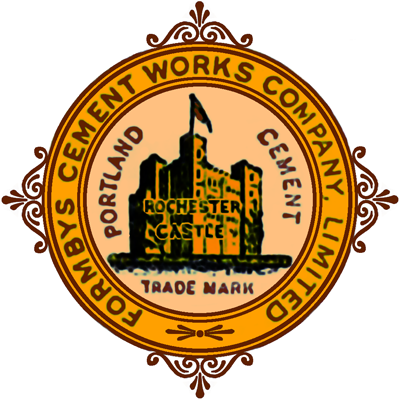The prospectus of the failed re-launch of the company in 1914 contains a list of the plant available on site at the time. The company was to be called The Whitewall (Medway) Portland Cement Company, Limited. The Directors were:
- Brigadier-General J. W. Hawkins, Chairman
- Denis Ripley Broadbent, Consulting Engineer
- Sir James Aloysius Power
- Beverley Griffin, Engineer, Wm Griffiths & Co., Ltd. contractors
OBJECTS OF THE COMPANY.- The objects of this Company comprise the acquisition of the Portland Cement Works (late the Property of the Formby's Cement Works, Co., Ltd.), situated at Frindsbury, on the River Medway, and the extension of the same for the manufacture of high-class Portland Cement under the title of this company.
DESCRIPTION OF FREEHOLD PROPERTY.- The property is freehold, and comprises an area of over 24 acres (9.763 Ha). The Company acquires all the fixed and moveable plant, machinery, works, kilns, fixtures, tools, tramways, rolling stock, and appurtenances connected therewith, manager's house, twelve workmen's cottages, and other buildings. The Property has an extensive river frontage, 750 feet of which is wharfage, protected by a river wall running parallel to the works, at which a number of barges can be loaded or unloaded at the same time.
An elevated tramway runs over the wharf carrying three loco cranes, each of three tons capacity, for loading and unloading the barges and carrying the raw material to and the manufactured cement from the works.
PLANT AND MACHINERY.- The existing Works, which are at present not in operation, will, by means of a small outlay (see reports), be immediately be available, and are capable of an output of 200 tons to 250 tons per week. Meanwhile, it is intended to erect new kilns, reconstruct the premises, and lay down additional plant. When the alterations and improvements under contemplation have been completed, the works will have ample Warehouse room, and will be equipped with the most modern and economical plant, including the latest crushing and grinding machinery, elevators, wash mills, Batchelor kilns, engineering and fitting shops, blacksmith's forge, and cooperage, and will be capable of turning out 2,000 tons of Portland Cement per week, or, say, 100,000 tons per annum.
The Report described the property as follows:
At present erected thereon are the following buildings, consisting of-
- Rope and General stores: Blacksmith's shop, 4-roomed Offices, Manager's Residence (containing 6 rooms, kitchen and scullery), and Main Factory Buildings, viz.:-
- No. 1. Engine and Boiler House, fitted with pair of 30 h.p. Compound Condensing Engines and 2 Lancashire boilers by Galloway & Sons, each 24' long by 7'6" diameter, working up to 80 lb pressure: Mill House, containing 4 pairs 4'8" Burr Stones, &c.: Concrete Store, divided up into Cement Bins: Bagging-up Shed, 4 Bottle and 2 Chamber Kilns, Drying Floors, &c.
- No. 2. Boiler and Engine House, fitted with 2 Galloway's Lancashire Boilers, recently insured up to 60 lb pressure, each 24' long by 6' diameter, and a 90 h.p. Horizontal Tandem Engine, with Patent Condenser: Two 16' Wash Mills, with Harrows and Slurry Elevators. Wet Mill, containing 3 pairs of Mill Stones and Chain Elevator.
- No. 3. Boiler and Engine House, with 2 Boilers by Messrs. Galloway, and a set of high and low pressure Surface Condensing Engines by T. Robinson & Sons, with Teague and Fleming's Automatic Expansion Gear and Tangey's Patent Condenser. The Dry(ing) Mill, containing 2 Colinson & Stacey's Mills, 1 pair of 4'8" Burrs with Hopper, shoots and Rubber Conveyor.
- 4 Chamber Kilns, 10 Bottle Kilns and Drying Floor, Sack Store, Bagging Shed, and three-bin Cement Store, Engineering and Fitting Shop, containing 12½" Centre Screw Cutting and Surfacing Lathe, by Lowden Bros., Glasgow. An 8½" centre ditto, Double Geared Drilling Machine, Planing Machine, 2 small Horizontal Table Engines and necessary tools.
- Stave Jointing Shop, with Jointing Machine: Boiler House, with 6 h.p. Vertical Boiler: Cooper's and Carpenter's Shops.
- Six Cottages, each containing six rooms, let at 4/- per week, and an Off-License Beer House, adjoining, containing 8 rooms, serving Bar, Cellar, and Scullery. Let to Mr T. J. Pinks, a tenant of over 24 years' standing, at £20 per annum. Also a row of Six Cottages, containing 4 rooms, washhouse, &c., each let at 3/- per week.
- A VERY VALUABLE ASSET IS THE ARTESIAN WELL, about 315' deep, giving an unlimited supply of water to the Works, and to the Cottages, same being worked by a set of 12" three-throw Pumps by P. J. Neate (late of Rochester), capable of pumping up to 24,000 gallons per hour.
The land is protected on all sides by a River Wall as a preventative from overflow at high tides, and has at one side thereof a Campshedded Wharf Frontage for about 750' with three 3-ton Travelling Cranes thereon for loading and unloading Goods from Barges which come alongside.
There followed of a rather vague description of the improvements planned, and the statement:
A MOST IMPORTANT POINT is that we are given to understand CONTRACTS HAVE BEEN ENTERED INTO FOR AN UNLIMITED SUPPLY OF CHALK AND CLAY at a reasonable rate, delivered at the Wharf.
The Prospectus was issued on 30/03/1914, and the approach of the War must have contibuted to the failure of the issue, but many plants considerably better than that proposed were being shut down at the time, and genuinely modern rotary kiln plants were being commissioned in the immediate locality.
